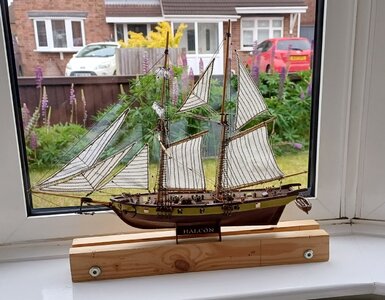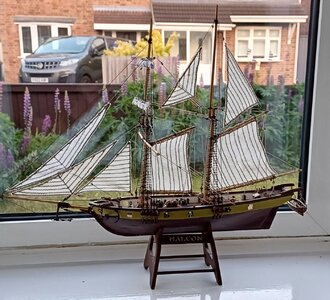My first ever venture into wooden model ships. It started out with "oh, that looks interesting when I saw the Halcon kit advertised for around GB£15 back in 2013. It got put away as we were moving house and resurfaced in May last year.
I was soon to discover that this was a cheap and nasty version of the kit. Having discovered this website and of members having similar experience with the Halcon.
I binned the cheap kit and bought another that cost me about GB£45. The kit was complete and had decent instructions.
Keeping track of other member's Halcon builds, I discovered the HisModel website in the Czech Republic. That set me off on wanting to make my model as realistic as possible, with rigging blocks and a great rigging diagram.
This led to me doing loads of research into ship builds and rigging from different periods.
My little ship finally left the shipyard last week and now, my wife has it displayed in our lounge window.
It's not a pretty sight. I made lots of mistakes. Broke it many times, with subsequent rework. The worst thing though, was wrong glue that I used on the ropes. (Rocket Hot - cyano glue). It was extremely fast setting, which was great, but the rope just soaked it up and ended up rigid. I will not make that mistake with my next ship.
So, apologies for such a messy model. It won't happen again.
I was soon to discover that this was a cheap and nasty version of the kit. Having discovered this website and of members having similar experience with the Halcon.
I binned the cheap kit and bought another that cost me about GB£45. The kit was complete and had decent instructions.
Keeping track of other member's Halcon builds, I discovered the HisModel website in the Czech Republic. That set me off on wanting to make my model as realistic as possible, with rigging blocks and a great rigging diagram.
This led to me doing loads of research into ship builds and rigging from different periods.
My little ship finally left the shipyard last week and now, my wife has it displayed in our lounge window.
It's not a pretty sight. I made lots of mistakes. Broke it many times, with subsequent rework. The worst thing though, was wrong glue that I used on the ropes. (Rocket Hot - cyano glue). It was extremely fast setting, which was great, but the rope just soaked it up and ended up rigid. I will not make that mistake with my next ship.
So, apologies for such a messy model. It won't happen again.







 .
.